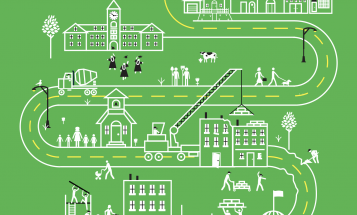
Subprime Students: How Wall Street Profits from the College Loan Mess
On the financial industry's shady involvement in student loan debt.
Five years after Wall Street crashed the economy by irresponsibly securitizing and peddling mortgage debt, the financial industry is coming under growing scrutiny for its shady involvement in student loan debt.
For a host of reasons, including a major decline in public dollars for higher education, going to college today means borrowing—and all that borrowing has resulted in a growing and heavy hand for Wall Street in the lending, packaging, buying, servicing and collection of student loans. Now, with $1 trillion of student loans currently outstanding, it’s becoming increasingly clear that many of the same problems found in the subprime mortgage market—rapacious and predatory lending practices, sloppy and inefficient customer service and aggressive debt collection practices—are also cropping up in the student loan industrial complex.
This similarity is especially striking in the market for private student loans—which currently make up $150 billion of the $1 trillion of existing student loans.
As detailed in a July 2012 report by the Consumer Financial Protection Bureau and Department of Education, private student loans mushroomed over the last decade, fueled by the very same forces that drove subprime mortgages through the roof: Wall Street’s seemingly endless appetite for new ways to make profit. In this case, investor demand for student loan asset backed securities (SLABS) resulted in private student lenders—primarily Sallie Mae, Citi, Wells Fargo and the other big banks—to relax lending standards and aggressively begin marketing these loans directly to students.
Unlike federal student loans, private loans have higher and fluctuating interest rates and come without any flexibility for tailoring payments based on income. Before the SLABS binge, most private student loans were actually made in connection with the college financial aid office, which helped ensure students weren’t taken for a ride, or weren’t borrowing more than they needed to. Between 2005 and 2007, the percentage of loans to students made without any school involvement grew from 40 percent to over 70 percent. And the volume of private student loans mushroomed from less than $5 billion in 2001 to over $20 billion in 2008. The market shrunk back to $6 billion after the financial crisis as lenders tightened standards.
And just like the subprime mortgage market, not all students were aggressively targeted by these rapacious lenders. The largest percentage of private loans taken out in 2008 were by students at for-profit colleges. In 2008, just 14 percent of all undergrads took out a private loan while 42 percent of students at for-profit colleges took them out. And as we now know, these loans are sinking borrowers—with absolutely no ability to discharge these loans by filing bankruptcy.
The latest student loan default rates issued by the Department of Education show that the three-year default rates for those who started repayment between October 2008 and September 2009 was 13 percent nationally—an average masking sharp differences depending on the type of school the borrower attended. For-profit institutions had the highest average with nearly 1 out of 4 borrowers in default, compared with 11 percent from public institutions and 7.5 percent at private, non-profit institutions.
All these statistics mean that close to 6 million borrowers are in default (almost 1 in 6 borrowers) to the tune of a combined $76 billion, more than the combined annual tuition for all students attending public two- and four-year colleges.
And for the borrower who can’t make payments, the student loan industrial complex is not a good place to be. And it’s costly for taxpayers: the Department of Education paid $1.4 billion last year to debt collectors and guaranty agencies to chase down borrowers who weren’t paying their loans. And here’s where Wall Street grabs another slice of the debt-for-diploma system pie. As reported in the New York Times, of the $1.4 billion paid out last year, about $355 million went to 23 private debt collectors. The remaining $1.06 billion was paid to the guarantee agencies to collect on defaulted loans made under the old federal loan system, which they in turn often outsource to private collectors.
But wait, there's more: It turns out that two of the nation’s biggest banks own debt collection agencies that have contracts with the Department of Education to collect on federal student debt that’s gone bad: NCO Group, owned by One Equity Partners, the private equity arm of JP Morgan Chase and Allied Interstate, owned by Citi Venture Capital International, the private equity arm of Citigroup. Both of these debt collection agencies are distinctive in that according to a comprehensive report by the National Consumer Law Center, they have received the most complaints filed with the Better Business Bureau in a 3-year period. At the same time, NCOs performance in recovering past-due loans has made it one of the top performers for the DOE.
The new cop on the beat—the Consumer Financial Protection Bureau—is now going to be providing federal oversight of the nation’s largest debt collectors, which is welcome news. The Department of Education could also play an important role in rewarding good behavior by their debt collectors. As NCLC recommends in its report, they could incentivize humane treatment of debtors by penalizing agencies for large numbers of complaints filed against them and reward agencies with few complaints.
Over the last two decades, our nation—in a major shift from its historical roots—slowly privatized and financialized the responsibility of paying for college. The result is a system in which the entire pipeline of student loans—now the largest source of “aid” for most students—is fueled, serviced and collected by Wall Street.
The student loan industrial complex invites a more profound question: given the billions in profit generated by federal and private student loans, along with the billions in administrative costs absorbed by tax payers, is debt the most efficient and equitable way to provide access to higher education?



